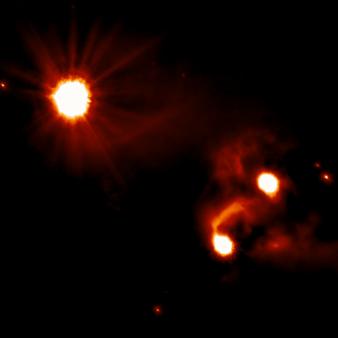![[Altair logo]](altair_logo.gif)
| You are in: Instruments > Altair > Hot News > News Update 01 July 2003 |
![[Altair logo]](altair_logo.gif)
|
Altair Hot News |
01 July 2003
After a 3 months rework at HIA and at Gemini (December-February 2002), Altair was back on the sky for 2 successful commissioning runs in April and May. The integration with the telescope, TCS and sequexec is basically completed. The system is now robust and has a high level of automation. Altair now achieves 55 to 85 milliarcsec images for seeing below 0.9 arcsec.
The third and fourth Altair commissioning runs took place from April 15 to 22 and May 8 to 16. After three months of rework at HIA and Gemini, these runs has been very successful. One by one, the major functionalities of the system, including the interactions with the telescope control system and the data acquisition sequencer, were successfully debugged, tested and characterized. Altair is now able to: (i) Receive signals from the instrument OIWFS (On-Instrument WaveFront Sensor) and use them to compensate for slow drift of image centering and defocus due to flexures; (ii) Offload at a slow rate the quasi-static shape of the deformable mirror to the telescope primary mirror; (iii) Offload the centering tip/tilt and defocus errors to M2; and (iv) Optimize several of the system operating parameters in real time such as modal gains and WFS centroid gain.
Altair is well integrated both with the TCS (Telescope Control System) and the TCC (Telescope Control Console). The telescope operator may now start and stop adaptive optics corrections from its TCC control screens.
After dealing with system functionalities, the main thrust of the team's effort during the last run shifted toward performance evaluation and improvements. Things are taking shape on this front. Images of full width at half maximum were obtained from 59 to 85 milliarcseconds (mas) on the vast majority of objects observed. This is slightly short of the ultimate diffraction limit (42 mas in H and 57 mas in K), but the main culprits have been identified. We have specific plans for improving these areas to reach our diffraction limited goals.
The team was generally very pleased with the behavior of the system. The rework at HIA and Gemini in the three months preceding the March run- including the refitting of a new lenslet array, work on the NIRI OIWFS gimbal mechanisms and several software improvement and fixes - has brought considerable improvements in the stability and overall performance of Altair. Following these successes, we are more confident than ever that the Gemini facility AO system will be fully competitive with its most serious competitors (e.g. NAOS).
Investigation of how faint a guide star the system can use were done during the May run. We have been able to close the loop successfully on a M6 V=15.4 magnitude guide star at 100Hz. Of course, this is a very red star. For K0 stars, the limiting magnitude is expected to be around 14.5, obviously providing partial compensation only (see the pages on Altair performances for more details).
During the next commissioning run in July, we expect to concentrate on the remaining problems and gray areas, including:
 |
Left: 22x22 arcsec K prime band image of V1318 Cygni (click to enlarge).
|
Last update March 3, 2003; Francois Rigaut.